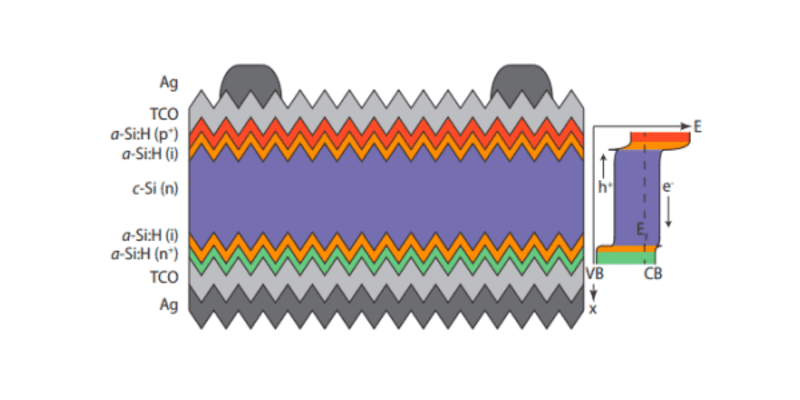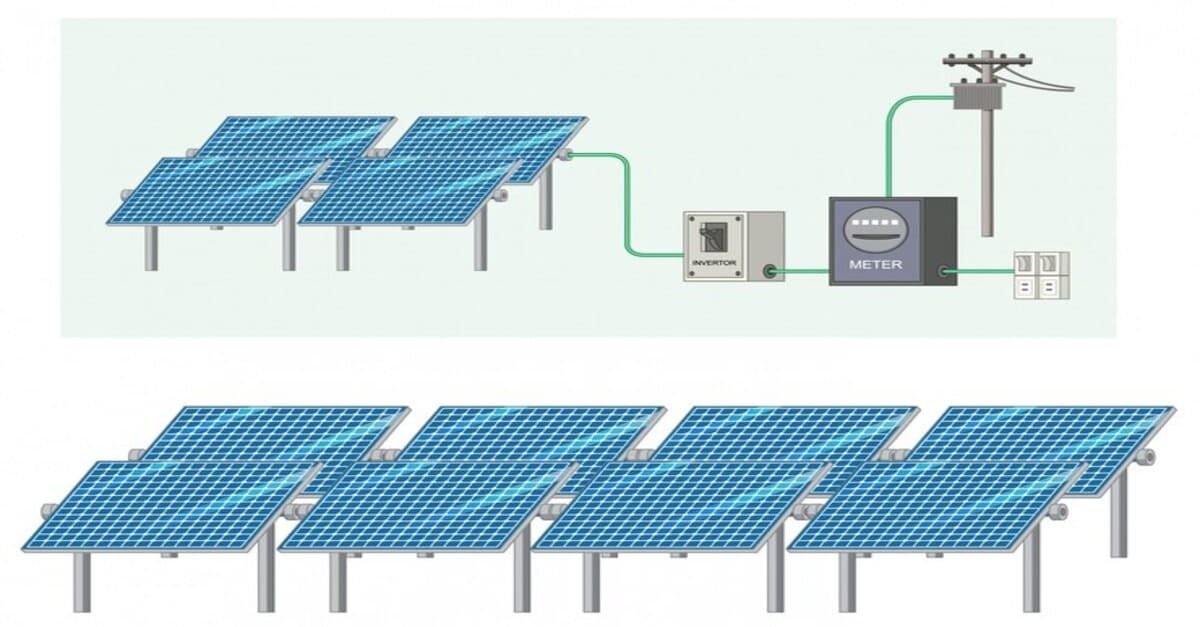As solar technology advances, more reliable, affordable, and efficient options become available, reshaping the future of renewable energy. Heterojunction (HJT) technology in solar panels is one invention that has attracted a lot of interest. In addition to providing a significant increase in conversion efficiency, HJT addresses a number of the drawbacks associated with conventional photovoltaic (PV) modules.
Here is a thorough introduction to HJT technology in solar panels, covering everything from understanding its composition and structure to investigating its uses and prospects.
What Is Heterojunction Solar?
In the solar business, heterojunction technology, or HJT, is a relatively new strategy that is gaining attention. In contrast to conventional solar panels, HJT solar cells are made of a blend of various semiconductor materials, most often silicon. As a result, there might be a greater production of power per installed solar watt, increasing efficiency.
How Does HJT Work?
Sunlight is captured by HJT solar panels, which then transform it into power. This is an explanation of how it works:
- The HJT, which is made of a crystalline silicon (c-Si) wafer with incredibly thin layers of indium tin oxide (ITO) and amorphous silicon (a-Si), is illuminated by light.
- The silicon layers absorb photons, which raises the electrons’ energy levels.
- The photovoltaic effect, a phenomenon where an electric current is generated, results from this.
Materials Required to Manufacture a Heterojunction Solar Cell
Crystalline silicon (c-Si), amorphous silicon (a-Si), and indium tin oxide (ITO) are the main components of HJT. These components are essential to the development of the unique solar cell layers that are essential to HJT’s success.
-
Crystalline Silicon
C-Si, which is present in most solar technologies, serves as the primary base for the solar cell and is the structural core of the HJT structure.
-
Amorphous Silicon
The thin-film layer method is crucial for maximizing light absorption and improving the solar cell’s efficiency.
-
Indium Tin Oxide (ITO)
By acting as a transparent conductive oxide (TCO) layer, ITO lowers the cell’s overall resistive loss by improving the efficiency of electron mobility and light capture.
Structure of the Heterojunction Solar Cell
A HJT cell typically comprises a sequence of layers:
- A c-Si base layer is enclosed between two intrinsic a-Si: H layers.
- Doped a-Si: H layers are positioned on the intrinsic layers to help manage the passage of electrons and their holes.
The meticulous stack of these layers ensures high performance and reliability.

HJT Manufacturing Process
What makes HJT solar cells special and important in the solar market may be understood by looking at how they are made. An outline of the lengthy production procedure is provided below:
1. Wafer Processing
Manufacturers meticulously prepare this core material, beginning with a silicon wafer, to make sure it is free of flaws and able to create heterojunction cells of the highest caliber.
2. Wet-Chemical Processing
Here, various chemical treatments are employed to clean the wafer surface and etch away any imperfections, readying it for the next phase of the build.
3. Core Layer Deposition
In this critical step, the intrinsic a-Si: H layers are deposited on the wafer. This layer thickens and anchors the panel’s ability to absorb light effectively.
4. TCO Deposition
The ITO film is applied, laying the groundwork for superior electron movement. This step enhances the solar cell’s conductivity without hampering light penetration.
5. Metallization
To wrap up production, the cell’s conductive contacts are structured, promising a well-distributed flow of electricity across the entire panel.
Types of Heterojunction Solar Cells
Depending on the doping applied throughout the production process, HJT cells can be broadly divided into n-type and p-type categories. The kind used may affect how well the panel performs and how efficient it is under various circumstances.
Heterojunction vs. Traditional Crystalline Silicon Panels
HJT technology’s preceding are conventional solar panels, which are built on monocrystalline and polycrystalline silicon. HJT panels, however, have several benefits over them, such as:
- Higher Efficiency: HJT cells have been shown to convert a larger percentage of sunlight into electricity.
- Good Temperature Coefficient: This refers to the temperature sensitivity of the cells and can directly impact their annual energy output.
- Ease of Manufacturing: Despite its complexity, HJT technology presents a promising roadmap to cheaper mass production.
Heterojunction vs. Bifacial Panels
Light from the front and back surfaces can be captured by HJT and bifacial panels. However HJT has an advantage in overall performance because of its special architecture, which enables it to perform better in some situations.
What Is the Difference Between HJT and PERC Cells?
The widely used technology known as Modified Emitter and Rear Cell (PERC) enhances conventional c-Si panels. With its heterogeneous cell structure, heterojunction technology goes one step further than PERC, providing even more durability and efficiency.
Benefits of HJT Panels
For solar adopters, Heterojunction (HJT) technology offers a plethora of advantages. HJT panels have many advantages, including excellent temperature coefficients, ease of manufacture, high durability and efficiency, and a strong case for use in a range of applications.
-
High Efficiency
Compared to conventional panels, the HJT construction’s mix of c-Si and a-Si enables a better conversion of sunlight to electricity, making it a leader in the quest for increased energy yields.
-
Good Temperature Coefficient
HJT panels are perfect for areas where ambient heat could pose a problem to regular solar panel functioning because they exhibit minimum power loss even in high-temperature situations.
-
High Bifaciality
Because of its unique design, HJT cells can generate more power and provide greater flexibility in terms of installation and operation by utilizing solar energy from both the front and the back.
-
Easy Manufacturing Process
HJT panels are made using a very simple manufacturing method, which ensures efficient production despite the complex technology required. This is a major economic benefit.
-
Large Size
HJT technology is a viable option for utility-scale solar farms that need to generate a lot of power because it can accept larger sizes without experiencing a major reduction in efficiency.
Future with Heterojunction Technology
HJT technology is on a high-speed path that is expected to continue growing and integrating into the solar energy sector shortly. With anticipated improvements and enhancements in the upcoming years, it is not out of the question for HJT to emerge as a major force in the market.
Applications of Heterojunction Solar Panels
Because of its adaptability, Heterojunction (HJT) technology may be used for a wide range of tasks, including powering small gadgets and acting as the foundation for large-scale solar arrays. It is a desirable option for many energy needs due to its excellent performance and ability to adapt to different situations.
-
Limited Space Applications
HJT’s dense power generation can be extremely helpful in situations where there is a limited amount of space available for solar panels, such as on urban rooftops or portable installations, as it maximizes every square inch of available space.
-
Power Source for Wearable Devices
Because of its efficiency and compact size, HJT panels are a good fit for wearable technology, providing dependable and continuous power generation for our portable electronics.
-
Utility-Scale Applications
HJT has a higher power output than conventional panels for large-scale energy projects, requiring less land for a higher energy output. Given the rising need for renewable energy around the world, it is proving to be an invaluable tool.
The Installation Process of HJT Solar
Careful installation is necessary when implementing Heterojunction (HJT) technology to make sure the panels are suited for their intended use. This comprises elements that can impact the panel’s performance, including as angle, orientation, and environmental influences.
- Determine the Optimal Location: The best position for maximum sun exposure must be chosen before installing HJT solar panels. This involves taking into account elements like the orientation of the roof, shadowing from surrounding buildings or trees, and the sun’s angle throughout the day.
- Prepare the Mounting Structure: The mounting structure that will support the panels has to be ready for installation. Depending on where the structure is being installed, this may entail fastening it to the ground or the roof.
- Install Racking System: Once the mounting structure is in place, the racking system must be installed. This provides a secure and stable foundation for attaching the panels.
- Connect Panels: After the racking system is installed, the HJT panels can be connected using specialized connectors. This creates one continuous circuit that will generate electricity.
- Secure Panels to Racking: Once the panels are connected, they can be securely attached to the racking system using clamps or brackets.
- Position and Angle Panels: For best results, the panels must be positioned and angled correctly. To guarantee optimal solar exposure, the tilt angle should be modified according to the installation site and season.
- Connect Solar Inverter: The direct current (DC) electricity produced by the solar panels must be converted into alternating current (AC) by the solar inverter for it to be used in residences and commercial buildings. It needs to be linked to both a power source and the panels.
- Test and Monitor: Once the installation is complete, it is important to test and monitor the panels for proper functionality. This includes checking voltage levels and monitoring energy production.
- Maintenance: Regular maintenance of HJT solar panels is crucial to ensure optimal performance and longevity. This can include cleaning the panels, checking connections, and monitoring energy output.
- Enjoy Clean Energy: HJT solar panels are now prepared to provide clean, renewable energy for a variety of uses, helping to create a more sustainable future, after the installation procedure is over. So, to fully utilize HJT technology, appropriate installation is necessary. In general, meticulous planning and attention to detail are necessary for the installation of HJT solar panels to guarantee effective and dependable power output.
Pros and Cons
Every technology has advantages and disadvantages. HJT is no exception, offering several benefits along with obstacles that researchers and developers are working hard to overcome.
Pros:
- Unmatched efficiency
- Durability and resilience
- Versatility in various usage scenarios
- Sustainable manufacturing
Cons:
- Upfront costs can be higher than traditional panels
- Limited market penetration currently
- Materials used can be rare or costly
- Research is ongoing to reduce the environmental impact of production
Conclusion
Heterojunction (HJT) technology contributes to the worldwide movement toward sustainability by filling in a portion of the wider picture of our energy revolution. The potential of HJT to provide cleaner and more efficient power is a ray of hope for businesses, consumers, and environmental advocates in our fight for renewable energy.
